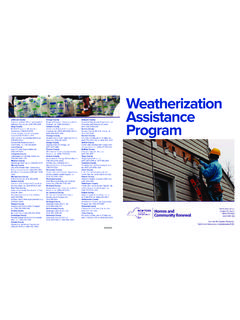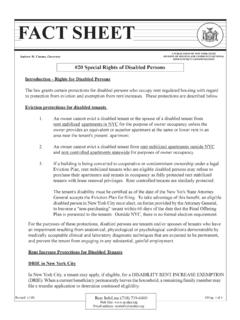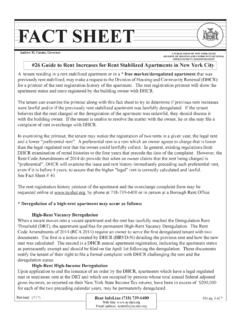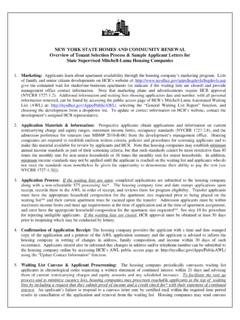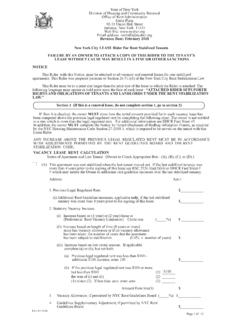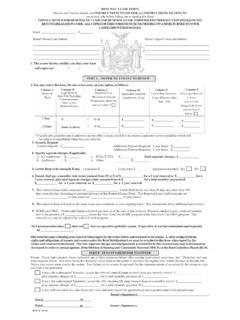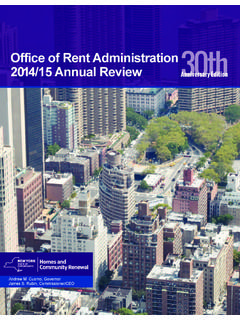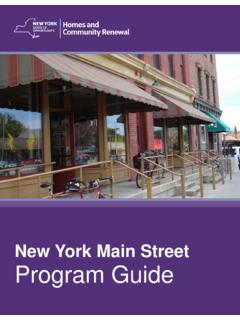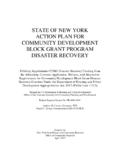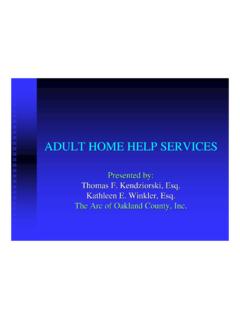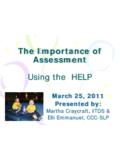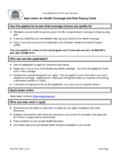Transcription of HELP FOR NEW YORK STATE HOMEOWNERS …
1 This information is made possible byNew york STATE Homes& Community Renewal and NeighborWorks America, and was developed by the New york STATE Coalition for Excellence in Homeownership Education (CXHE) and Empire Justice Center. What is Foreclosure ? What is commonly called a foreclosure is a lawsuit that the mortgage holder files against a homeowner in the supreme court where the property is located. The mortgage holder is usually a bank or finance company. New york is a judicial foreclosure STATE , which means that the lender has to sue the borrower in order to enforce their rights under the mortgage and note. If the lender wins the lawsuit, it obtains a judgment from the court, which allows the lender to sell the property at an auction.
2 The money received from the sale is used to repay the debt. Foreclosure begins when the lawsuit is filed. A homeowner is considered in foreclosure until a judgment is made by the court. If you do not know the exact stage of fore closure you are in, you can find out from the supreme court in the county where the lawsuit was filed. You need to find the docket sheet to find out the status of your foreclosure. To find your case, have the complaint or other court paper that shows the index number (usually at the top right), or search by name. You may be able to access docket sheets online, depending on the county in which the foreclosure was filed. You can also go to the clerk s office in the local supreme court and ask for a docket sheet that shows all actions taken in the court case so far.
3 The Mortgage and the Note When you borrow money to buy a home, refinance a home loan, or take out a home equity line of credit such as for home repairs, you sign two contracts with the lender: the Note and the Mortgage. The Note is the agreement that the lender is lending you money and your personal promise to pay it back. The Note includes the terms and conditions of repayment, such as the interest rate, term of the loan, and charges for late fees. The Mortgage is a separate contract that gives the lender a security interest in the property your pledge of the home as collateral for the loan. The mortgage explains what the lender can do if terms of the note and mortgage are not met, such as going ahead with a foreclosure on the mortgage for failure to pay under the note.
4 Pre Foreclosure Steps The Acceleration Letter: Before filing a foreclosure against a homeowner , a lender must send an Acceleration Letter to the borrower. The letter tells the borrower that the lender will accelerate the entire amount of the mortgage if the arrears (the total amount overdue) are not paid by a certain date. The Acceleration Letter is sent to the borrower after the borrower defaults on the loan. A borrower is usually considered in default on a loan after missing one payment, though the Acceleration Letter is often not sent until the borrower is 2 to 3 months in default. help FOR NEW york STATE HOMEOWNERS CONCERNED ABOUT FORECLOSURE Understanding New york STATE s Mortgage Foreclosure Process Understanding New york STATE s Mortgage Foreclosure Process 2 90 Day Pre Foreclosure Filing Notice: Under New york STATE law, the lender must send the borrower a special notice at least 90 days before filing a foreclosure summons and complaint.
5 The notice must have specific language and must attach a list of at least 5 nonprofit housing counseling agencies located near the borrower. The Foreclosure Process Step 1: Lender Files Summons and Complaint The lender files a Lis Pendens (a pending lawsuit) in court. The lis pendens warns all people that title to the property is in litigation. The lender also files a Summons and Complaint with the court, which initiates the lawsuit. The lender serves the Summons and Complaint on the borrower(s). Step 2: Affidavit of Service, Request for Judicial Intervention, and Attorney Affirmation The lender files an Affidavit of Service with the court, which sets the date and states how it served the borrower.
6 At this time, the lender must file a Request for Judicial Intervention ( RJI ) with the court to notify the court that it must schedule a mandatory settlement conference. The lender also must file an Attorney Affirmation with the court. If the lender fails to file the RJI, the borrower may file the RJI to make sure that the mandatory settlement conference is scheduled. Step 3: Borrower Files an Answer The borrower must file an Answer to the summons and complaint with the court within 20 days of the date of receipt if the summons and complaint were served in person, or within 30 days if they were sent by mail or delivered in another way. This is your opportunity to explain why you think there were errors regarding your mortgage origination and/or servicing.
7 You must send a copy of the Answer to the lender s lawyer as well as the court. If you do not want to file an Answer but you do want to be notified of future court actions, file a Notice of Appearance with the supreme court in your county. This means you should receive written notice of all future proceedings, including the auction of the house. (If you file an Answer, you do not need to file a Notice of Appearance.) Note: Failure to File an Answer: If the borrower fails to file an Answer, the borrower defaults. If the borrower defaults: The lender files a motion with the court for an Order of Reference, asking the judge to appoint a referee to add up the total amount owed to the lender according to the terms of the mortgage, including principal, interest, late charges, and foreclosure fees and costs; After the referee adds up the total amount owed, the lender files a motion with the court to request the court to enter a default Judgment of Foreclosure and Sale.
8 Understanding New york STATE s Mortgage Foreclosure Process 3 After the judge signs the Judgment of Foreclosure and Sale, the lender publishes a notice about the auction in a newspaper at least 30 days before the auction date, and then may schedule an Auction of the property by the referee. If the borrower never filed an Answer or a notice of appearance, the lender is not required to give notice of the sale to the borrower. Step 4: Mandatory Settlement Conference Within 60 days of filing the affidavit of service, the court must hold a mandatory settlement conference to see if the lender and homeowner (s) can reach a mutually agreement solution. The court sends a notice to the borrower stating the date, time, and place of the conference, and tells what to bring.
9 Step 5: Litigation and Discovery Phase A. If a settlement cannot be reached in the settlement conference, litigation begins and the case goes into the discovery process. The discovery phase is when the opposing parties in the lawsuit request documents from each other. The borrower should send a request for discovery to the lender. The borrower may receive a request from the lender, as well. B. Motions: The lender files a Motion for Summary Judgment if it believes the borrower s defense lacks merit (the evidence is weak or doesn t prove wrongdoing). A motion for summary judgment is a request for the court to rule in favor of the lender even though the borrower filed an Answer in response to the summons and com plaint.
10 The lender does this if it believes the borrower has not presented evidence that their defenses have merit. To continue fighting the foreclosure, the borrower must file an Answer to the Motion for Summary Judgment and include documentation that supports their defenses. A copy should be sent to the lender s lawyer as well. If the judge grants the lender s motion for summary judgment, the lender will move for an Order of Reference as described in the note for step 3, and will then seek an auction date. Step 6: Trial If the case is not resolved by settlement or by motion, the lawsuit proceeds to trial. , 09 12
